When you take your first bite from a warm slice of dutch oven sourdough bread, you’ll realize that nothing tastes better than the flavor of freshly bread made from scratch at home! This classic no knead sourdough recipe has just 4 ingredients, and the dough can rise throughout the day or overnight. With a little patience and our step-by-step instructions you can be enjoying a loaf before the end of the day!
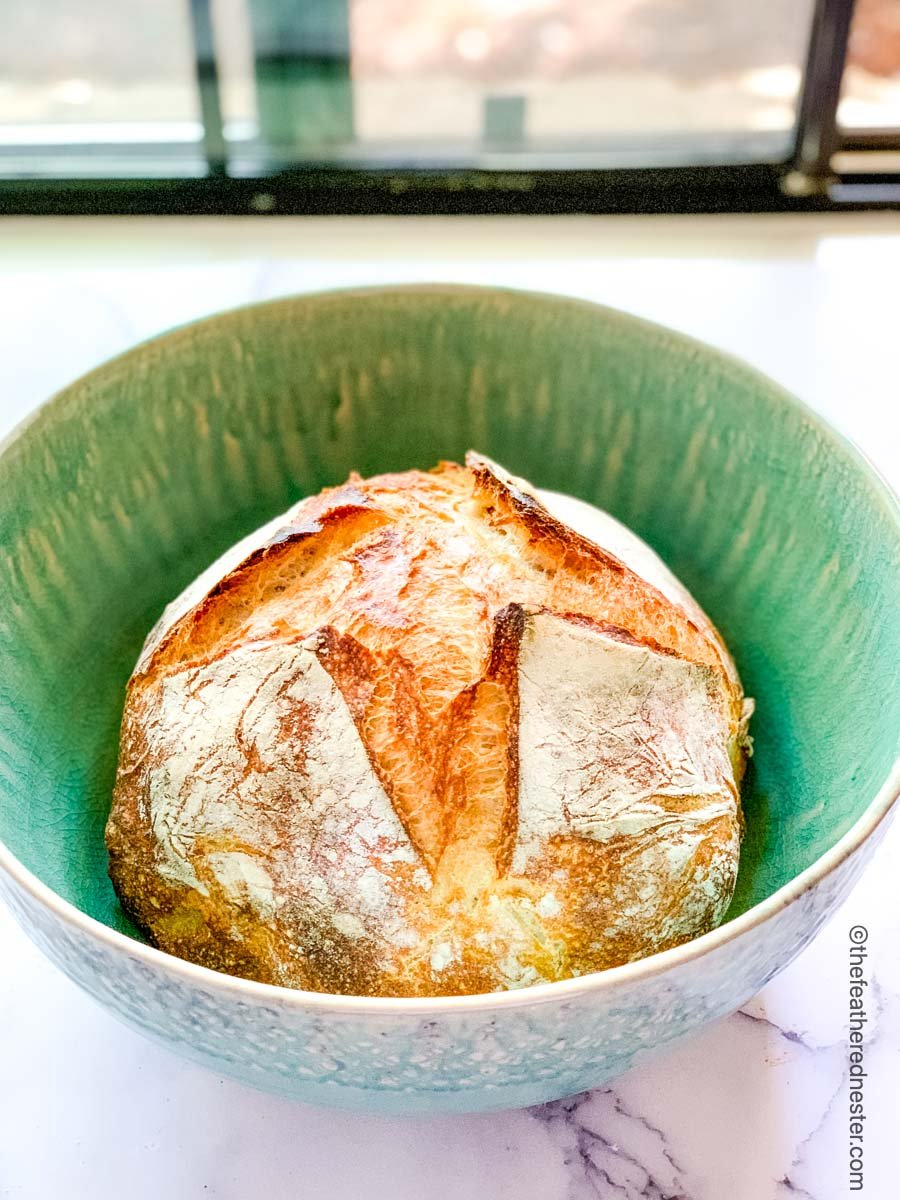
Content Covered Here
Why We Love This Recipe
- This no knead sourdough recipe makes a classic round boule, baked in a Dutch oven or pot using wild yeast to rise your bread. Instead of kneading, you just do an easy set of stretching and folding.
- Each bite has that signature sourdough tanginess that will have you craving another slice. This yields a rustic, artisan-style loaf that is slightly crispy and chewy on the outside, and fantastically fluffy and soft on the inside. In other words, this easy recipe makes the most amazing bread!
- For those who live in colder climates, you’ll love that the dough can be left to rise during the day versus overnight – when it’s typically colder and therefore more difficult to get a great rise in the evening.
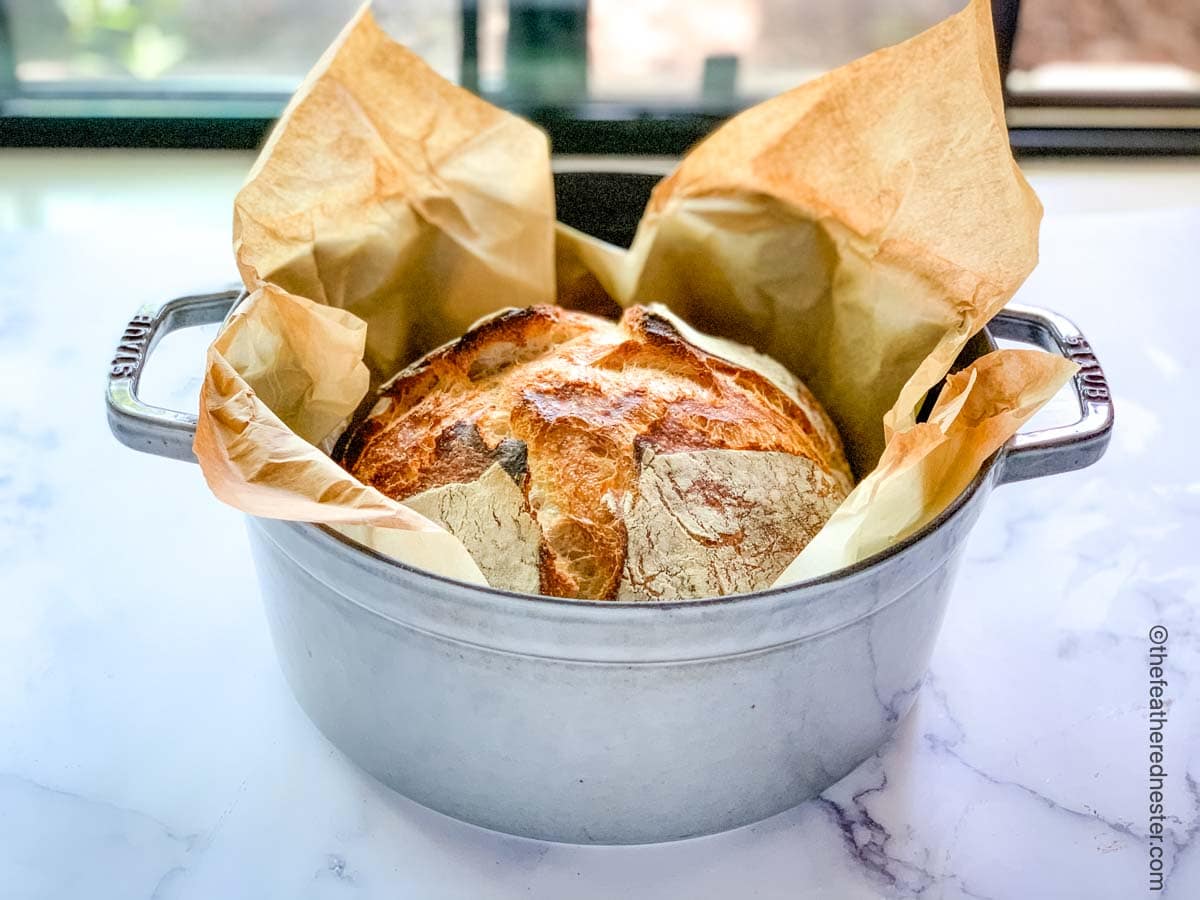
Sourdough is fantastic for making all kinds of tasty baked goods. From sweet treats like sourdough apple coffee cake to savory pizza crust, you can also make some sourdough breakfast recipes out of it. A good sourdough starter is about the most versatile ingredient in the kitchen!
Ingredient Notes and Substitutions
There are only 4 ingredients (including water) needed to make a delicious loaf of sourdough bread from scratch:
- Active Sourdough starter – fed 12-24 hours before starting the recipe.
When we say active, we mean a mature starter that is at least a week old and always doubles in size within 4-6 hours of feeding. It doesn’t mean you need to use it at the peak activity after a feeding. - All-purpose flour – you can substitute bread flour for some of the all-purpose. See the recipe cards for exact amounts.
If you’d like to make a whole wheat loaf, we recommend making our no-knead whole wheat sourdough bread recipe instead! - Fine salt – any type of salt work though I prefer using fine sea salt. If you use Kosher salt, increase it by 25%.
- Warm filtered water or bottled water – ideally, the temperature of the water should be about 105°F or baby bottle warm. If the water is too hot, it will damage the starter and you’ll have a flat loaf.
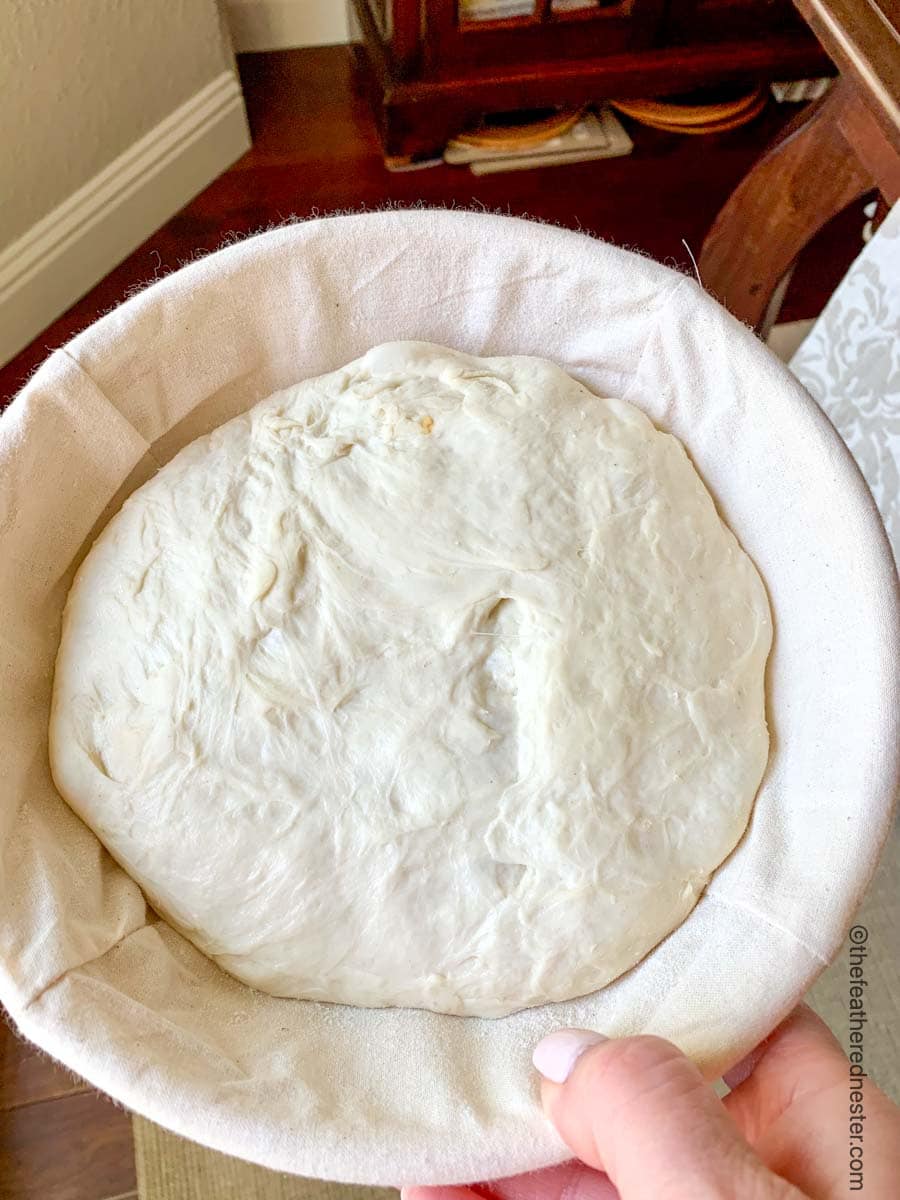
Recipe Variations
If you prefer extra tangy sourdough bread, replace 1/4 teaspoon (up to 1/2 teaspoon) of the salt with citric acid or sour salt for a tangy kick to your bread.
Are you looking for a soft sourdough bread that is not baked in a Dutch oven? Super soft king arthur sourdough sandwich bread is great to keep on hand for lunches (kids love it!), and a is always welcome on the dinner table.
Use an egg wash and sprinkle with dried herbs before for an herby flavor.
Equipment and Supplies
We recommend using a 4-quart to 5-quart Dutch oven or heavy pot with a tight fitting lid for baking this sourdough bread recipe. The smaller size supports the bread during its fast rise in the oven and provides a taller loaf.
A dough whisk is handy for stirring the thick batter.
Using a clear large mixing bowl for rising makes it easier to see the fermentation activity going on below.
Parchment paper is essential for this recipe, as that’s how we add the dough to the cast iron pot.
Plastic wrap to cover the bowl during fermentation keeps the dough from drying out if you live in a dry climate.
Check out our other sourdough recipes or our list of sourdough recommend tools.
How to Make Sourdough in a Dutch Oven
Below are the foolproof step-by-step directions for making this amazing bread. You’ll love how easy (and delicious!) this bread is!
Mix the Dough
- Add the sourdough starter to a large glass bowl. Stir in the water until the starter is completely dissolved. Now add the flour and salt. Use a dough whisk or wooden spoon to stir until a thick and shaggy dough forms. If it’s too thick you can finish mixing the dough by hand. Leave the dough in the bowl, and cover it with a clean and slightly damp kitchen towel. Let the dough rest for 30 minutes.
- Next, activate the gluten by using the stretch and fold method for 15 seconds in the bowl, until the dough tightens and is more difficult to stretch. Doing this creates surface tension in the dough.
Grab the edge of the dough, stretch it up, and press it down into the center of the dough, then turn the dough 1/4 a turn. Continue stretching the dough as you move in a clockwise rotation.
To see the technique, check out the video tutorial on the recipe at the bottom of this post. - Cover the bowl with a clean damp towel or plastic wrap if you live in a dry climate. Let it rise in a warm area (75º to 80º F) for the fermentation process to happen. See our recipe notes for a proofing time guidelines.
Looking for a shorter fermentation rise recipe to use up your sourdough discard? You’ll love our sourdough discard naan! Use it for wraps, naan, or even pizza. Best of all, it only has a one hour rise so you are ready to serve them fast.
🎯 TFN Pro Tip
If the ambient temperature is less than 70°F, you may need to let the sourdough rise for up to 12 hours. See the recipe for a fermentation rise time guide.
Save This Recipe!
Ideas for keeping dough warm during colder months:
- Use a heated mat (like those used for germinating seeds) for rising.
- Use the “proof” setting of your oven (Renae sets hers to 85ºF) and set a timer. This will speed up the rising process, so check it at 4 and 6 hours.
- If there is a sunny room in the house that stays warm, keep the dough covered in that area.
- Place the bowl in the oven with the door closed and light on to create a slightly warmer climate without actually turning the oven on.
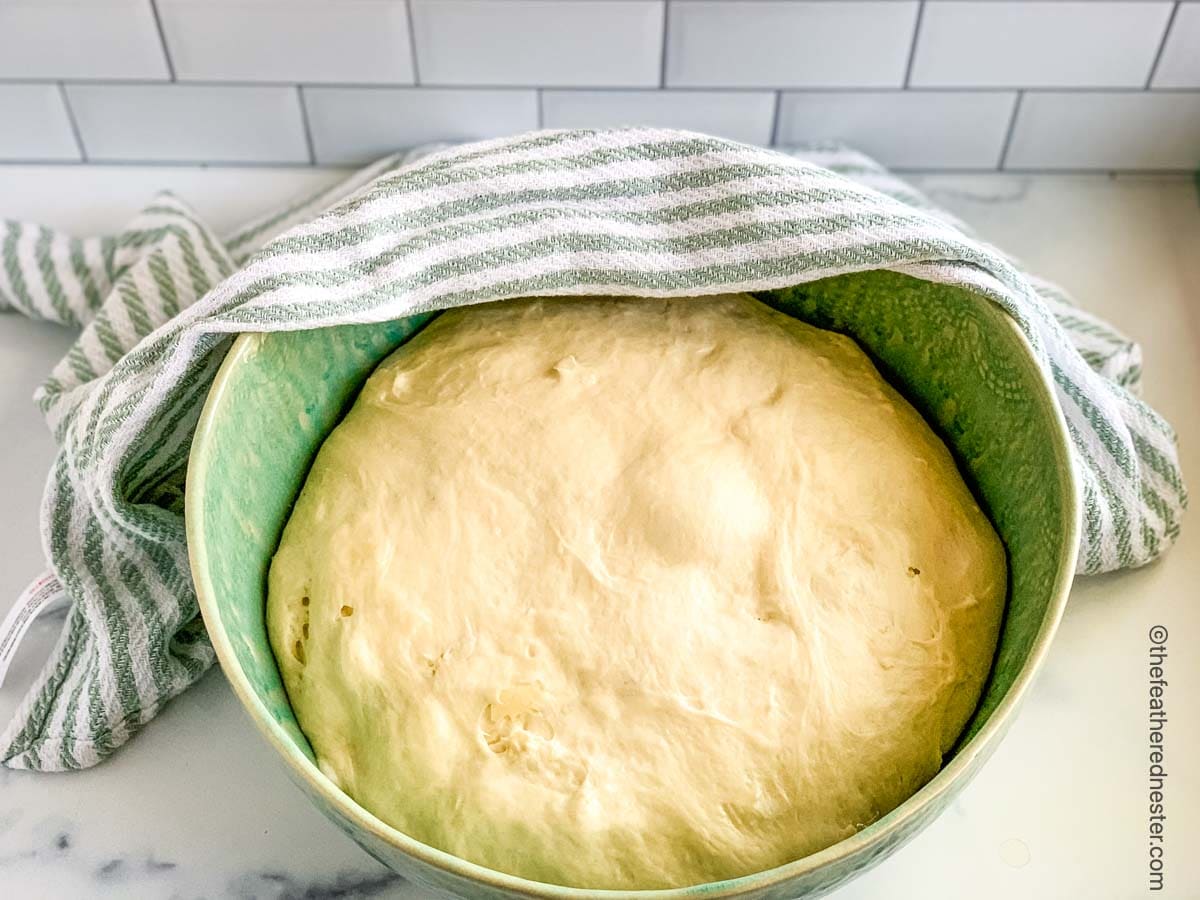
After the long, fermentation rise the dough will have risen about double and look bubbly with large air bubbles underneath.
Shape the Loaf
- Now let’s shape the loaf. Tip the bowl and pull the dough onto your lightly floured surface. Stretch and fold the dough again as you did before, until the dough tightens. Cover and let the dough rest for 10 minutes.
- In the meantime, line a medium bowl with a towel or use a banneton proofing basket with a linen cover (see photo), and dust heavily with flour. Transfer the dough to the bowl and let it rise for 30 – 60 minutes.
Bake the Bread
- Preheat your oven to 450º (without the cast iron Dutch oven). Cover the dough bowl with a long piece of parchment paper, and turn it over onto the countertop so that the dough is on top of the parchment paper. It should hold its shape well.
- Next, slash the top of the loaf with a lame (covered razor blade) or sharp knife. This will allow the steam to escape and the crust to expand without cracking. Gently lower the parchment paper with the dough into the Dutch oven.
- Add the lid to the heavy pot and bake the covered bread for 30 minutes. Then remove the lid and bake for another 20 minutes.
Use oven mitts to carefully remove the bread from inside the pot (on the counter covered with a trivet or stovetop is best) and bake the loaf directly on the oven rack for 10 minutes, until it’s golden brown. - Remove from the oven and let the sourdough bread cool for at least 1 hour before slicing and serving.
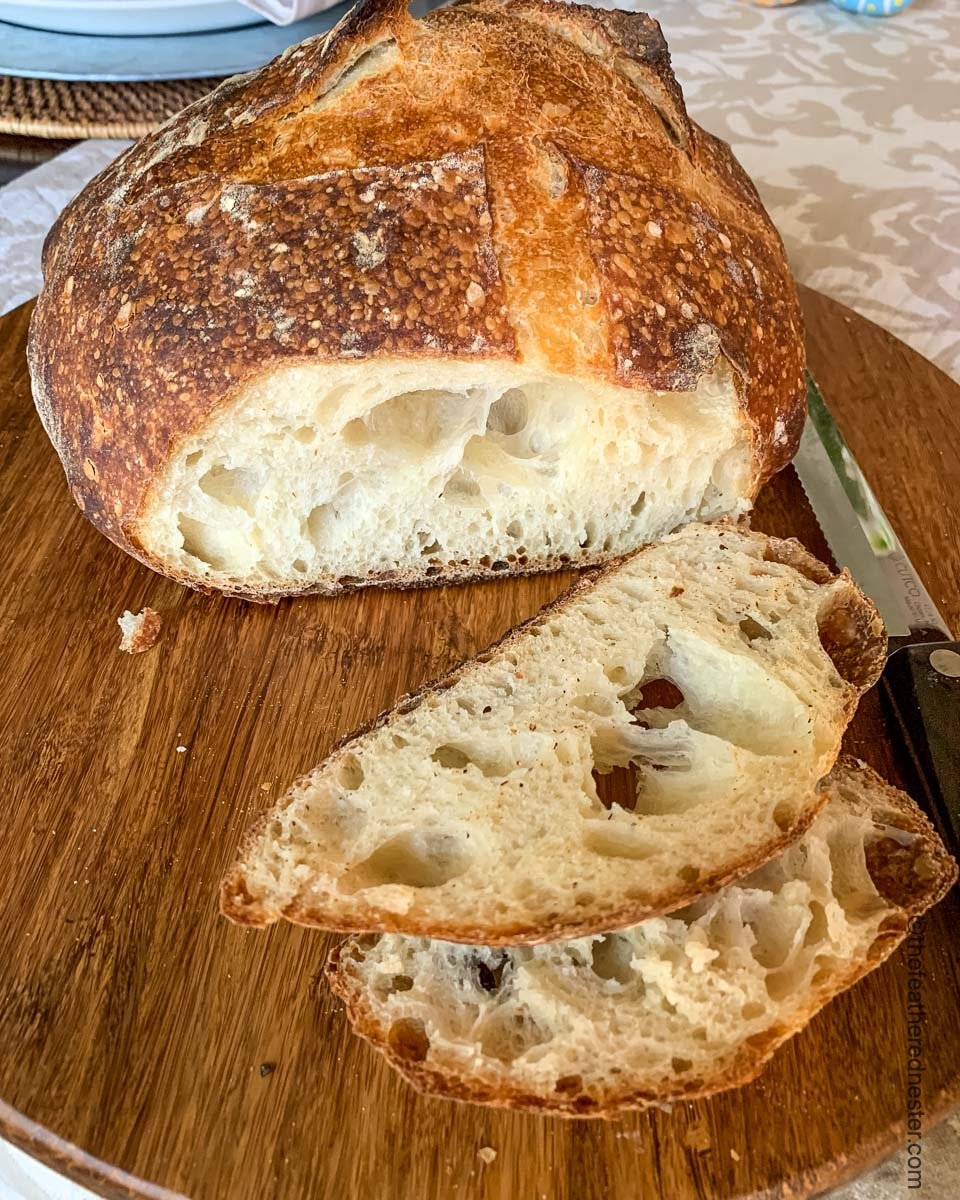
Recipe Tips
- Using a round Dutch oven will give you the typical round sourdough loaf. But, you can use an oval pot instead.
- Use the same brand of flour for consistent results. I prefer using King Arthur Organic All-Purpose flour, Arrowhead Mills Organic All-Purpose Flour, or Wheat Montana Premium All-Purpose Flour.
- Use a glass bowl to proof the dough. This will let you see the bubbles throughout the dough that let you know the dough is ready.
- Keeping the dough warm (70º to 85º is ideal) during the bulk rise is key for proper fermentation. See the recipe notes for actual rise times and tips below for how to keep your sourdough dough warm.
- If your Dutch oven has a dark bottom, like Lodge or Staub, use an oven-safe trivet or round silpat liner to keep the bottom from darkening.
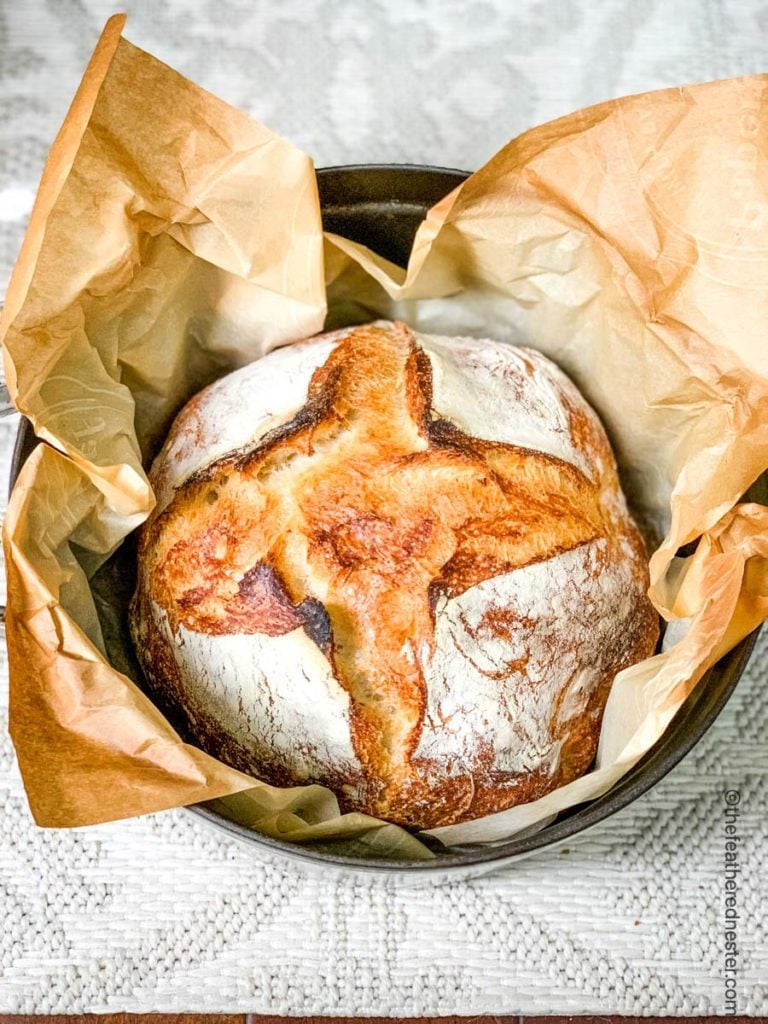
Serving Suggestions
This bread is incredibly versatile! Enjoy its crispy crust and chewy interior with classic butter and jam, elevate your breakfast with avocado toast spread featuring your favorite toppings, or indulge in a hearty soup and bread combo for a comforting meal.
Recipe FAQs
When it’s ready, the dough should be about double in size, with a slightly bubbly tip and active air bubbles underneath. This is where a glass bowl comes in handy. You’ll be able to see more bubbles on the underside of the bowl.
See our Fermentation rising or proofing guide in the recipe below for estimated bulk rising times.
Yes, you can substitute all-purpose flour 1:1 with bread flour.
Store sourdough in a sealed bag or container and keep it at room temperature for up to 5 days.
Yes, you can substitute up to 1/2 of the all purpose flour with whole wheat flour. I don’t recommend using all whole wheat flour as this yields a denser loaf. Also, add 1 Tablespoon of vital wheat gluten to get a higher rise.
If your starter is at least a week old and doubles in size within 4-6 hours of feeding, then it should be ready to bake bread. I don’t recommend using the float test as it’s never worked for me.
Use it for low rise recipes like sourdough discard pancakes or sourdough apple cake.
More Sourdough Discard Recipes to Try…
- Sourdough Discard Pizza Dough No Yeast
- Sourdough Cinnamon Rolls
- Sourdough Discard Banana Bread
- Grilled Cheese on Sourdough
If you tried this Dutch oven sourdough bread recipe or any other recipe on my website, please leave a 🌟 star rating and let me know how it went in the 📝 comments below. Thanks for visiting!
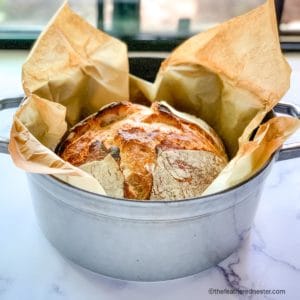
Dutch Oven Sourdough Bread
Equipment
- dough whisk - optional
Ingredients
- ¼ cup (60 grams) active sourdough starter fed within 12-24 hours *see notes
- 1 ½ cups (350 grams) filtered water about 100º F.
- 4 ¼ cups (500 grams) all-purpose flour *See recipe notes for using bread flour
- 1 ½ teaspoons (9 grams) fine salt *we prefer using sea salt
Instructions
- In a large bowl, add the sourdough starter. Add in water and use a dough whisk or a wooden spoon to stir until dissolved. Stir in the flour and salt until a shaggy looking dough forms. Finish mixing dough by hand in the bowl until all the flour has been absorbed. Cover the bowl with a clean, damp kitchen towel and let the dough rest for 30-45 minutes.
- Lightly flour your countertop. Pull the dough from the bowl with a dough scraper or by hand onto the countertop. Stretch and fold the dough for 15 seconds (see video below): grab the edge of the dough and bring it straight up it about 4 inches and tuck it into the center of the dough. Then, turn the dough 1/4 a turn. Continue this process until the dough has come full circle and it has tightened.Return the dough to the bowl, cover with a damp towel (or plastic wrap if you live in a dry area) and and let rise at room temperature or a warm area (70º to 80º F) for 4-9 hours (see chart in notes) to ferment. Do not refrigerate the dough. The dough should be about double in size and look puffy on the surface and bubbly under the dough when fermented.
- Lightly flour your countertop. Pull the dough from the bowl and shape the dough by stretching and folding it again. Let the dough rest 10 – 15 minutes. Line a medium sized bowl with a towel, or use a banneton bowl with linen cover (see photos), and dust heavily with flour. Let dough rise in it for 45-60 minutes.
- Preheat your oven to 450º (without the dutch oven). Cover the dough bowl with a long piece of parchment paper, about 20 inches long, and turn it over onto the countertop (see video). Slash the top of the loaf with a lame or sharp serrated knife. Gently lower the parchment paper dough into a heavy pot with a tight-fitting lid. NOTE: If using a Dutch Oven with a dark interior, I recommend insulating the bottom with a round silicone sheet underneath the parchment paper. You can also place the pot on a baking sheet. This helps the bottom crust of the bread from getting too dark in color.
- Place the covered pot in the the oven and bake the bread covered for 30 minutes. Remove the lid and bake 20 minutes. Using oven mitts, carefully remove the bread from the pot. Bake it directly on the oven rack for 5-10 minutes to crisp the exterior (if needed). To ensure your bread is cooked through you can check the internal temperature. It should be 195ºF to 205ºF.
- Let cool for at least 1 hour before serving.
Video

Notes
- If your starter is active (it doubles in size 4-6 hours after feeding) and was fed within 12-24 hours of starting the recipe, your sourdough might not be warm enough during the overnight rise.
- Find a warm place (ideally 75º- 80º F) like a cool oven with the light on, a warm window, or above the refrigerator or dryer to set the bread for 2 hours. Then continue with the recipe.
- Use a 9″ round Silpat silicone sheet, as I do. I place it in the bottom of my Staub cast-iron Dutch oven.
- Dutch ovens that are darker in color tend to brown the bottom of the bread more.
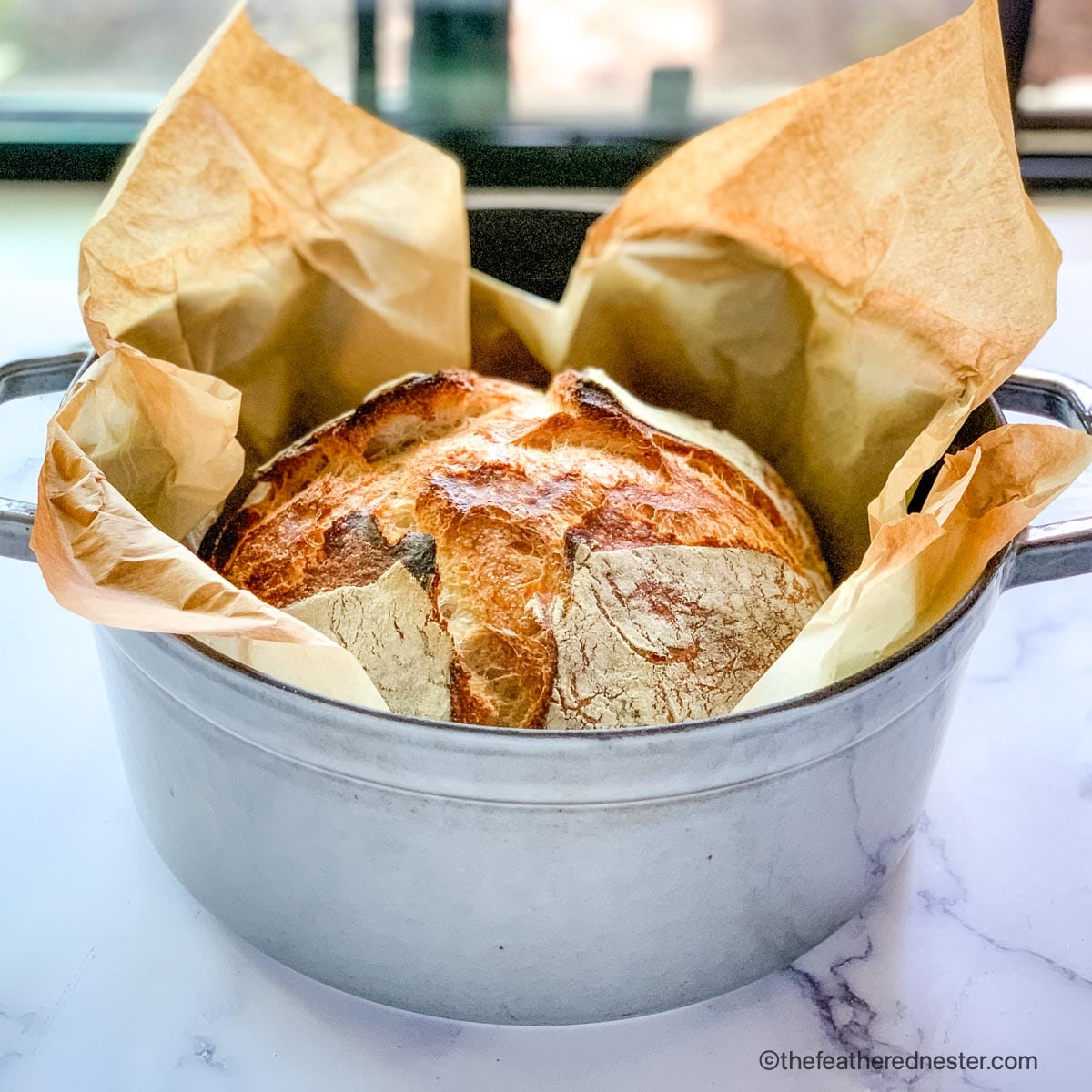




Brittany says
Love love love this recipe! It’s the best bread I’ve ever made and this recipe is hard to mess up! I didn’t have time to bake this morning so after the dough was done rising overnight I shaped it and popped it in the fridge for about 8 hours. Took it out and put it in the oven cold and it might have been my best batch yet! Will continue to use this recipe forever.
Keely says
I’ve been making this recipe for months. Every two weeks I make two loaves. Everyone LOVES my bread. The last two times now I’ve done exactly the same thing and my dough has been extra wet and didn’t rise quite the same. Both times I got a denser and kind of gummy loaf. I’m going to try strengthening my starter so it’s on the counter for more feeding for a bit.
Bianca A. says
My dough has come out awfully sticky, much stickier than in your video. So much so that when I did the pull and stretch step my hands were pretty covered in dough. Do you know why this may have happened? And how I can prevent this next time?
Thank you!
Gianne - TFN Team Member says
Hi! How did you measure your ingredients? We recommend weighing them to have more accurate ingredient measurements.
Ruth says
If your dough is too sticky, add flour as you knead/need (ha ha) and the bread will turn out just fine.
Karly Cataudella says
I just used this recipe to make my very first loaf today and it turned out amazing!! The only thing is, the bottom got a little too done for my liking. I used a Dutch oven but the interior is a light color. Is there a way I can prevent the bottom from getting too done?
Gianne - TFN Team Member says
Hi Karly, You may use a trivet or round silicone liner to go inside the Dutch oven (https://rstyle.me/+zpnNbxEqSpzj9_dXk6kIuA) before you add the bread dough to keep the bottom from getting too dark. I find that using a Dutch oven with a light-colored interior also helps prevent the bread from browning on the bottom.
Christina says
I’ve used this recipe multiple times and my bread always turns out great, I am having a little trouble with getting my bread to rise… mine always seems to be on the smaller side… any tips would be greatly appreciated!
Gianne - TFN Team Member says
Hi Christina! Do you mean like your bread comes out a bit smaller? Sometimes it can be difficult to troubleshoot without knowing your home conditions, but I will try and help with a few different ideas. If you are using flour by the cup instead of a scale, I’d try weighing all ingredients next time to see if that makes a difference. Sometimes people keep their starters more or less hydrated, and this can also throw off the ratio of flour/starter/water. What does the dough feel like prior to the bulk rise? It should be pretty shaggy and dry, and then at the point of stretching and folding, it should be more elastic, wet but not sticky.
Nancy says
Love this recipe made it several times. Question I tried out putting a cookie sheet underneath the Dutch oven still got too dark of a crust not sure why?
Gianne - TFN Team Member says
This tends to happen more with Dutch Ovens with darker bottoms. We use this round silpat silicone sheet to prevent this from happening: https://amzn.to/3WqR5JR . Measure the bottom of your pot so you get the right size.